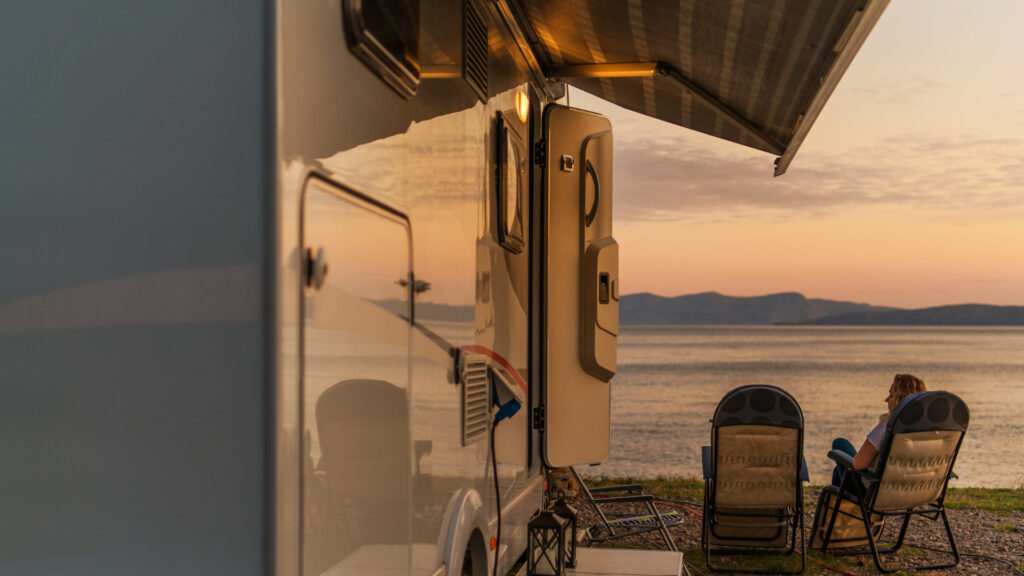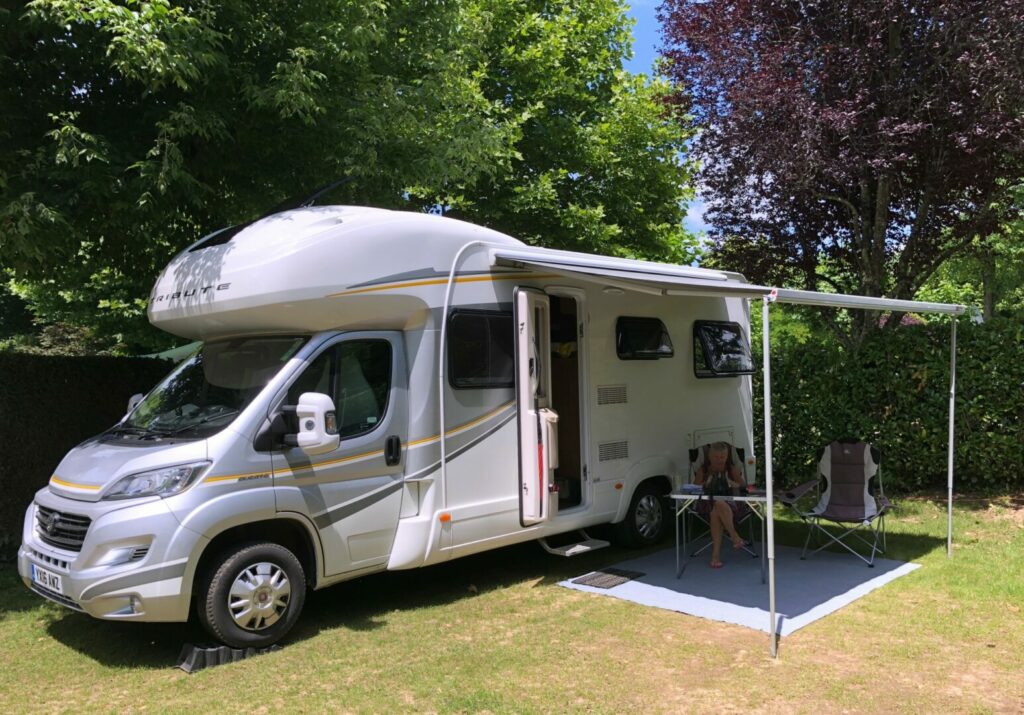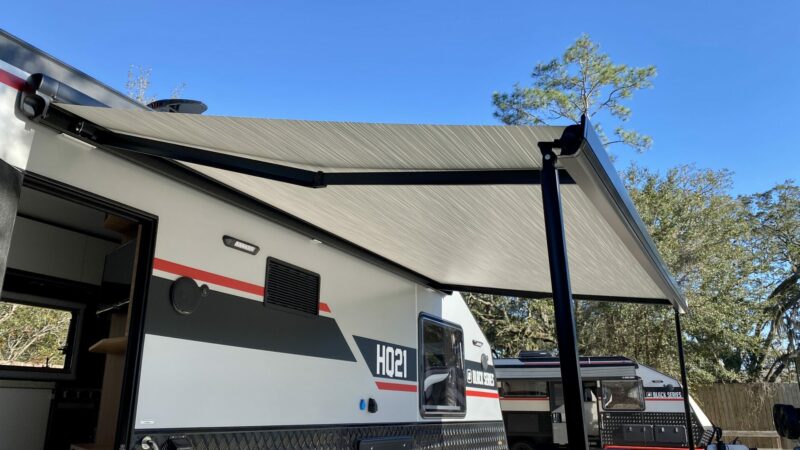Table of Contents Show
When you purchase an RV, you probably have glamorous plans of relaxing in the shade of your awning as waves crash against the shore in the summer. If you don’t do beach camping, you at least want to sit outside under your camper awning and read a book among birds chirping.
Your camper awning can make or break your outdoor experience. So if it doesn’t cut it, you’ll be searching for a replacement quickly.
Let’s look at different camper awnings and which ones are worth investing in to provide the shade and protection you desire while spending time in nature!
What Is a Camper Awning?
A camper awning extends the living space of your RV by providing additional shelter outside.
By extending your awning, you’ll have shade on hot summer days and protection from the rain during those spring months.
Some RVers attach mesh patio walls to enclose the space for further protection from bugs and weather.
So when they walk out of the door, they walk into a comfortable, spacious outdoor patio area.

How Long Do RV Awnings Last?
Camper awnings are notorious for poor design and lack of durability. Although they’re supposed to last at least five years, some don’t make it that long.
On the other hand, with proper maintenance and a bit of good fortune, other RV awnings will last for 15 years or more.
It’s critical that RV owners know how to properly care for their camper awning.
Washing it regularly will prevent mildew build-up and protect the fabric from deterioration.
Keeping a wet awning extended instead of rolling it up also prevents mildew build-up.
Tightening the bolts and lubing the metal tracks are also good maintenance procedures every so often to increase the life of your camper awning.
How long an awning lasts can also directly relate to poor decisions by the owner.
If you leave it out during a thunderstorm, you risk a gust of wind ripping it off the side of your RV.
If you ignore how close you are to a tree, you risk bending the awning arms if you extend it into the tree or other edifice. Y
ou can avoid certain things to protect your camper awning and help it last as long as possible.
Pro Tip: Many campers ask Can You Leave Your RV Awning Out in the Rain? Click to find out!
Are All Camper Awnings the Same Size?
Camper awnings come in all sizes. The length along the RV and extension vary.
A small travel trailer like the 20-foot E-Pro by Flagstaff comes equipped with a 12-foot awning.
A long toy hauler fifth wheel, like the 45ft Fuzion, comes with two awnings: a 10-foot awning and an 18-foot awning.
The 22-foot Rockwood Roo pop-up camper has a 15-foot awning, while the 32-foot 9-inch Winnebago Minnie Winnie has a 10-foot awning.
The length is dependent upon the RV length and design.
Camper awnings also extend to different lengths. Older campers will usually have ones that extend about 8 feet from the camper. Newer models may have awnings that extend as far as 14 feet.
What Is the Difference Between Vinyl and Acrylic Awnings?
Depending on where and how often you camp, you can choose between a vinyl awning and acrylic awning to suit your needs.
Vinyl awnings are waterproof because vinyl is a non-breathable material.
This is great for rainy days but not so great for hot days. Airflow is limited through a vinyl awning.
However, these awnings are very durable because of the vinyl fabric and last for years if properly cared for.
On the other hand, acrylic awnings provide better airflow through the lightweight, breathable fabric.
If you’re camping in hot conditions often, this fabric is best.
However, it’s not as long-lasting as vinyl. Acrylic awnings also need to be cleaned often to prevent mildew as these are not waterproof.
Pro Tip: Keep your awning in great shape by knowing how to Safely Clean Your RV Awning!

What Are the Best Camper Awnings?
If you’re looking for the best camper awnings, plan to spend more money to purchase awning fabric that will last.
These replacement fabrics are stronger, more durable, and UV-resistant than the standard options.
They come in various sizes and colors, so you’ll find the perfect match for your RV.
Pro Tip: If your awning doesn’t come with lights, here are some of The Best RV Awning Lights to upgrade to!
SunWave Fabric Awnings
These SunWave options are fabric only. Meaning, they don’t include mechanical or manual arms.
If you’re looking to replace your acrylic or vinyl awning fabric, the SunWave selections are tri-laminated durable 15 oz vinyl and 16 oz heavy duty 1000 denier weather-guard.
They vary in length from 8 feet to 22 feet. Make sure to note the type of awning you currently have because the SunWave replacement fabrics fit the Carefree, Dometic (A&E), and Carter awnings.
SunWave also provides a limited three-year warranty on fabrics and a lifetime warranty for hardware.

Shade Pro Vinyl Fabric Awnings
Available in heavy-duty 15 oz three-ply vinyl, premium 13.5 oz three-ply vinyl, or marine grade acrylic, Shade Pro awning fabrics are durable alternatives to standard camper awning fabrics.
The vinyl options are mildew resistant and come with a three-year or five-year warranty. The acrylic options dry quickly and have good air circulation.
Shade Pro offers awnings fabrics in black, charcoal, gray, beige, burgundy, blue, and green. They can also create a custom color to match your RV.
If you’re in California or Arizona, they’ll even install the replacement fabric for an additional cost.
RecPro RV Awning Fabric
RecPro provides an entire line-up of RV awnings, awning replacement parts, replacement fabrics, shades, and more.
The replacement fabrics are available in six colors and range from 8 feet to 22 feet. The durable vinyl material resists tears and punctures.
It’s also waterproof, UV-resistant, and mildew resistant. Another reason the RecPro awning fabric is so durable is the seams are heat-welded instead of sewn. These fabrics can withstand temperatures well below freezing.
Bonus: Use the discount code “XQJZNRT” to receive 5% off of your entire RecPro order!
ALEKO RV Awning
ALEKO provides full replacement awnings and not just replacement fabrics.
From an 8-foot by 8-foot manual retractable awning at $469 to a 21-foot by 8-foot motorized retractable awning at just over $1,000, ALEKO has awnings for all types of RVs.
The 100% PVC fabric material provides protection from the sun and rain and resists mildew and fading.

How Much Does It Cost to Install a Camper Awning?
The entire installation of a camper awning could cost anywhere from $500 to $4,000 depending on the length, type, and fabric.
A mechanical awning will cost more than a manual awning. It will also take more time to install. If you hire a mobile tech to install a camper awning, you’ll also be paying labor costs.
You could save quite a bit of money by installing it yourself, but you also risk installing it incorrectly.
That could damage your rig or the awning in the process, and you’d have to pay a mobile tech to come out and fix the problems in the end.
Pro Tip: Save money by Repairing Your RV Awning Yourself! Let’s see how!

Is It Worth Replacing My Camper Awning?
If you’re going to pay $1,500 to $2,000 to install a camper awning, it’s worth considering the pros and cons. That’s a steep price to pay for something you may only use a couple of times a year.
However, if you love spending time outdoors and rarely hang out in your RV, spending the money to create a comfortable outdoor space might be worth it.
With so many different types of camper awning options, you can still find something that works if you’re on a strict budget. Have you ever installed a camper awning? Was it worth it?






